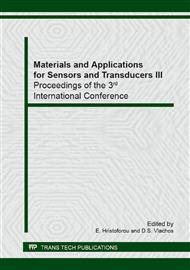p.376
p.380
p.384
p.388
p.392
p.396
p.400
p.404
p.408
Piezoelectric Self-Excited System in Mining Roof Anchor Stress Change Measurement
Abstract:
The paper presents the application of a new type of a measurement system called Self-excited Acoustical System (SAS). It was applied for stress change monitoring of anchors which are used to secure roofs and walls in mines and in hollowed tunnels. The knowledge about the state of anchors can indirectly indicate the state of rock masses which is crucial for mining safety. One of the main problems so far has been reliable sensor mounting, especially in difficult mining conditions. The SAS system overcomes this problem because it can be mounted easily at the anchors end or even on the anchors flange. The laboratory tests were conducted on a hydraulic tensile testing machine. The mining roof anchor was placed in the machine and then stretched. The changes of the resonance frequency caused by the increase of the tensile strength were observed during the research.
Info:
Periodical:
Pages:
392-395
Citation:
Online since:
April 2014
Authors:
Price:
Сopyright:
© 2014 Trans Tech Publications Ltd. All Rights Reserved
Share:
Citation:


